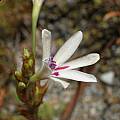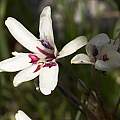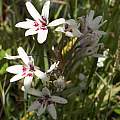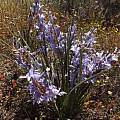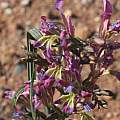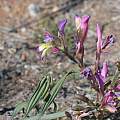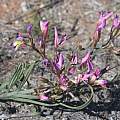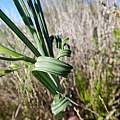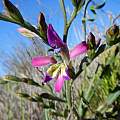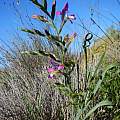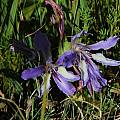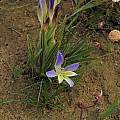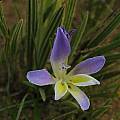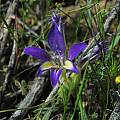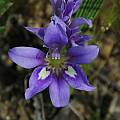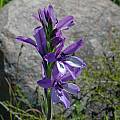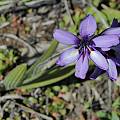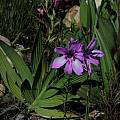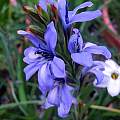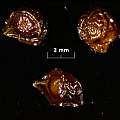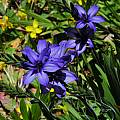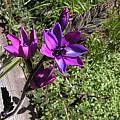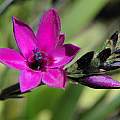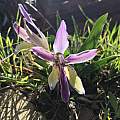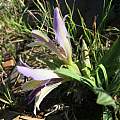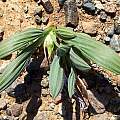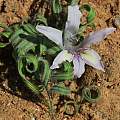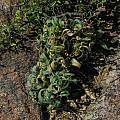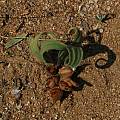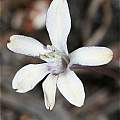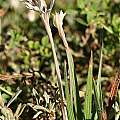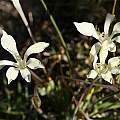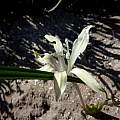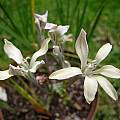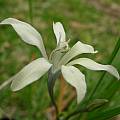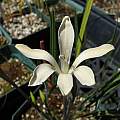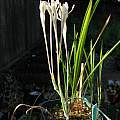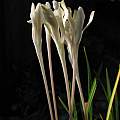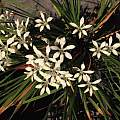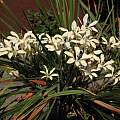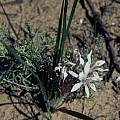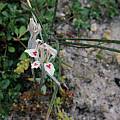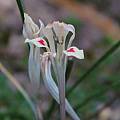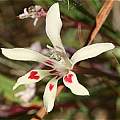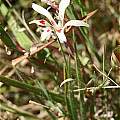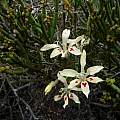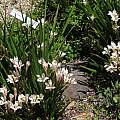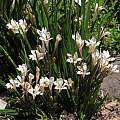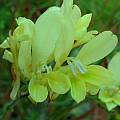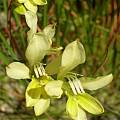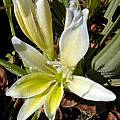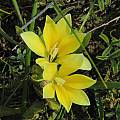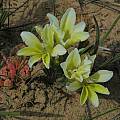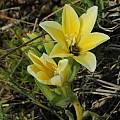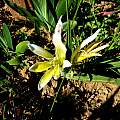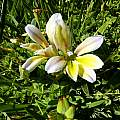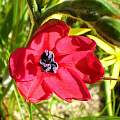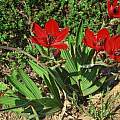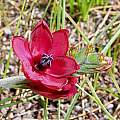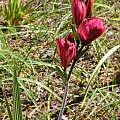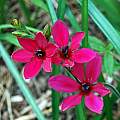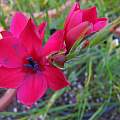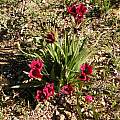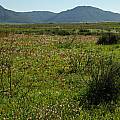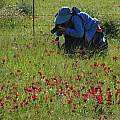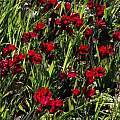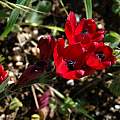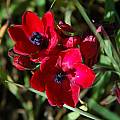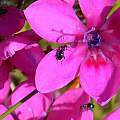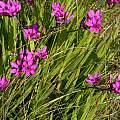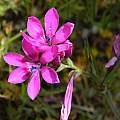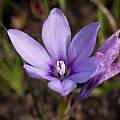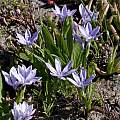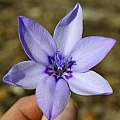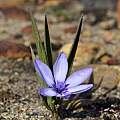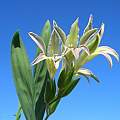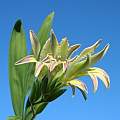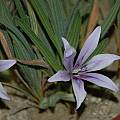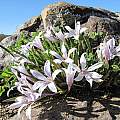Babiana is a large genus in the family Iridaceae from southern Africa. This genus was revised in 2007 by Peter Goldblatt and John C. Manning. Species sp-z are found on this page.
Babiana species a-h - Babiana species i-p - Babiana species r-si - Babiana index
Babiana spathacea (L.f.) Ker Gawl. grows in doleritic clay in karroid scrub in the western Karoo and flowers September to October. Flowers are cream or flushed lilac with small red markings and plants grow from 10 to 60 cm high. First photo by Alan Horstmann. Second and third photos by Michael Mace of a plant grown in California, where it blooms in mid-May. The last photo is from Rod Saunders.
Babiana spiralis Baker is found on stony granite hills and in deep red sands in the Northern and Western Cape in areas with low rainfall. Growing from 25 to 55 cm high, it has lanceolate or linear plicate leaves that are twisted or coiled above and brightly colored yellow and blue-mauve to pink flowers with a strong freesia-like scent. This species flowers August and September. The first three photos from Alan Horstmann were taken on the west coast in August. The last three photos from iNaturalist were taken by Gregory Nicolson and shared under a CC BY-NC license.
Babiana spp. photos below are pictures of babianas taken in the wild that were not identified to the species level. Any help in identifying them would be appreciated. Photos by Bob Rutemoeller and Mary Sue Ittner. The first picture was taken near Tulbagh and the others near Nieuwoudtville.
Babiana stricta (Aiton) Ker Gawl. has purple, blue, white or yellow flowers with stems overtopping the leaves and centrally placed dark anthers. It grows on clay soils in renosterveld from Piketberg to Swellendam and has been used in breeding to create many of the garden hybrids. The first three photos by Bob Rutemoeller and Mary Sue Ittner were taken August 2006 in Tulbagh.
The first photo taken by Mary Sue Ittner is of a garden plant. The second photo is from Alan Horstmann. The last photo of seed by David Pilling.
The photos below from Mary Sue Ittner are probably hybrids from Babiana stricta. They are descendants of a batch of seeds described as mixed species. They have been good garden plants, growing and increasing in the ground or as container plants. One flowers a couple of weeks before the other.
Babiana tanquana J.C.Manning & Goldblatt is native to the Western Cape where it is found in dolerite outcrops. Growing from 6 to 12 cm tall, it has flowers with dark purple upper tepals lined in pale lilac and yellow lower lateral tepals. Flowers have an acrid-musky scent. Flowering time is June and July. The first two photos from iNaturalist were taken by Brian du Preez in July in Tankwa Karoo National Park and shared under a CC BY-SA license. The last photo from Margaret Fox was taken in the Tankwa Karoo August 2022.
Babiana thunbergii Ker Gawl. was renamed to Babiana hirsuta by Goldblatt and Manning in 2008.
Babiana torta G.J.Lewis grows in crevices in granite outcrops or granitic gravel in Namaqualand. This early blooming (May to June) fragrant species has distinctive lanceolate undulate leaves twisted above the middle with pale blue to mauve or white flowers borne close to ground level. The lower lateral tepals have a pale yellow to white median blotch edged in dark blue. The first photo from iNaturalist was taken by Kevin Murray in July in Namaqualand and shared under a CC BY-NC license. The next two photos were taken in September 2007 in Namaqualand by Mary Sue Ittner of the distinctive leaves and of seed pods.
Babiana tubiflora (L.f.) Ker Gawl. was more recently considered to be a variety of Babiana tubulosa. Like that species, it is found in the Western Cape in coastal areas, but grows farther north (Lambert's Bay to Stilbaai) in sandy, mainly coastal flats and dunes. It also has white flowers, with or without small pink or red median markings on the lower lateral or all three lower tepals. Besides its different habitat, this species is less robust with smaller flowers and flower parts and the red markings on the lower tepals, if they exist, are small and obscure. This species takes 3 years to flower from seeds and grows happily in a small 4" pot.
The first three photos below were taken in habitat in the Western Cape by Andrew Harvie. The last photo was taken by Cameron McMaster near Velddrift, West Coast.
The photos below were taken by Cameron McMaster of plants in cultivation in South Africa.
The photos below show the same plants through several years of growth in cultivation. Photos 1-3 were taken by Nhu Nguyen of the plants when they bloomed the first time. Photos 4-5 were taken by Uluwehi Knecht of the same clumps, several years later in a one gallon pot.
Babiana tubulosa (Burm.f.) Ker Gawl. has small white to cream flowers flushed deep pink on the outside and an elongate perianth tube that is expanded in the upper portion in a wide gullet. It has prominent triangular to spear-shaped red markings on the lower tepals. It grows in the wild in the Western Cape on the hills between Mamre and Saldanha where it grows on well-drained slopes in gritty granite derived soil. Photos 1-3 by Bob Rutemoeller and Mary Sue Ittner. The first one pictured below was growing in the wild in the West Coast of South Africa and was photographed in 2001. Photos number two and three are plants grown by Rod and Rachel Saunders. Photos 4-5 were taken by Andrew Harvie in the Western Cape. The last photo was taken by Cameron McMaster near Jacobsbaai.
The photos below were taken at the UC Botanical Garden by Nhu Nguyen of some very nice plants.
Babiana truncata G.J.Lewis in the Babiana revision is now considered to be an inaccurate name and is now included under Babiana flabellifolia except for longer tubed collections which are now considered to be in a new species, Babiana cuneata.
Babiana unguiculata G.J.Lewis is found on seeps and seasonally wet sandstone flats in the Northwestern Cape. It has linear, sometimes twisted pleated leaves and yellow flowers in a crowded suberect spike. The lower lateral tepals are a darker yellow. The larger dorsal tepal arches over the stamens. Photos were taken by Alan Horstmann.
Babiana vanzijliae L.Bolus grows in rocky sandstone derived soils in fynbos and renosterveld on the Bokkeveld Plateau in the Northwestern Cape. This species has often been spelled as Babiana vanzyliae, but it was originally spelled differently and the Babiana revision returns it to the previous spelling. Flowers are yellow to pale blue-mauve with the lower lateral tepals with whitish median blotches. This species grows from 4 to 12 cm tall and blooms August to September. The photo from Dirk Wallace is a close-up.
The first photo from Mary Sue Ittner shows this species blooming in mass near Nieuwoudtville August 2001. Also in the picture is Hesperantha pauciflora and an unidentified pauridia (syn. spiloxene) possibly Pauridia serrata. Photos 2-4 were taken by Mary Sue Ittner and Bob Rutemoeller September 2006. Photos 5-6 were taken by Cameron McMaster September 2011.
Babiana villosa (Aiton) Ker Gawl. grows on clay flats and slopes in the southwest and northwest South Africa Cape. The flowers are mauve, pink, or dark red. The first photo was taken by Alan Horstmann. The second photo was taken by Rod Saunders. The next two photos below were taken by Bob Rutemoeller of plants flowering in Mary Sue Ittner's Northern California garden. The last two photos by Mary Sue Ittner are of a different color form.
This red flowered variety grows in the wild near Tulbagh. The first photo from Bob Rutemoeller was taken in 2003. The rest of the photos by Mary Sue Ittner and Bob Rutemoeller were taken August 2006 when it was blooming in mass along with Geissorhiza inflexa which was the exact same color and hard to tell apart from a distance.
Photos of another color form from iNaturalist taken by meldagoets in the Western Cape in October and shared under a CC BY-NC license.
Babiana villosula (J.F.Gmel.) Ker Gawl. ex Steud. grows on sandy flats and lower slopes in fynbos in the southwestern Cape and flowers May-July. Growing from 3 to 15 cm high, this species has radially symmetrical pale blue to mauve flowers with a white center. Photos from iNaturalist taken by carinalochner and Jan-Hendrik Keet and Chris Vynbos from June-August in the southwestern Cape and shared under CC BY-NC and CC BY-SA licenses.
Babiana virescens Goldblatt & J.C.Manning is endemic to southern Namaqualand where it occurs on granite hills in seasonally moist open ground. Growing from 7-20 cm and flowering in early winter (May, June), it has oblong leaves with thickened margins and pale grey-green, or flushed with greyish lilac, flowers with yellowish green median blotches and purple streaks on the lower lateral tepals. The tepals are unusually narrow and longer than the perianth tube. Photos from Alan Horstmann.
Babiana virginea Goldblatt grows in rock outcrops in the Roggeveld. It is 5 to 15 cm high with hairy pleated lanceolate leaves and white to tinged mauve flowers with pale yellow or cream colored blotches on the lower lateral tepals. The fragrant flowers bloom in September. The first photo by Bob Rutemoeller shows one growing in a container at an IBSA meeting in South Africa. The second photo from iNaturalist was taken by Nick Helme near Sutherland in the Roggeveld in September and shared under a CC BY-NC license.
Babiana species a-h - Babiana species i-p - Babiana species r-si - Babiana index
